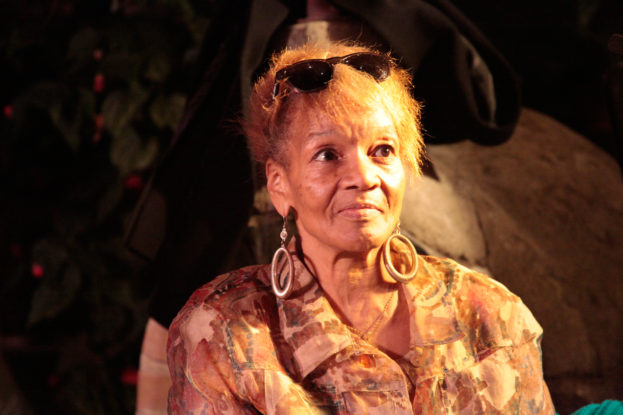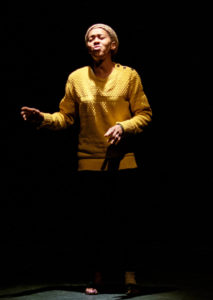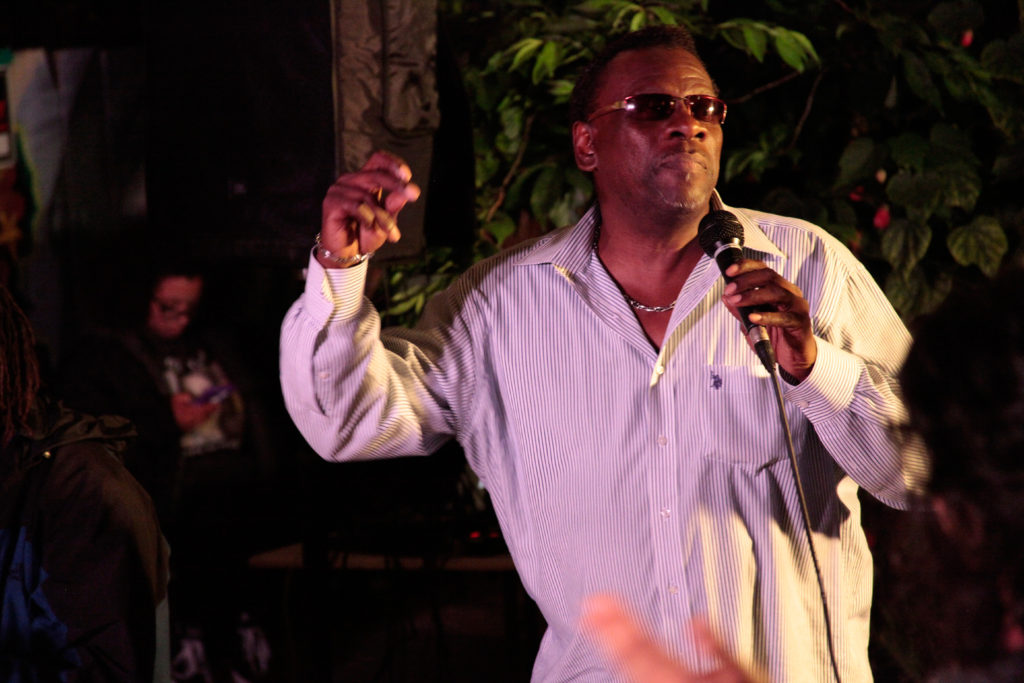
 On Wednesday, July 6 at 3:30 in the afternoon, San Francisco police are in a three hour standoff with an armed and suicidal man lying on Market Street with his hands in his pockets. Traffic is at a standstill and
On Wednesday, July 6 at 3:30 in the afternoon, San Francisco police are in a three hour standoff with an armed and suicidal man lying on Market Street with his hands in his pockets. Traffic is at a standstill and
a fractious crowd of bystanders looks on as time stands still in a normally bustling corridor where, over the last few years, skid row has met tech row. Against a national backdrop of lethal police violence against a series of mostly unarmed people of color, the incident thankfully ends without a fatality.
Oblivious to the commotion a few blocks away, I step into the Senator Hotel on Ellis Street, right behind a woman being buzzed in by the receptionist. Once a popular landing place for tourists, the 1924 building operates today under the auspices of the nonprofit Community Housing Partnership (CHP), which provides permanent supportive housing for its extremely low-income tenants. A plaque on the lobby wall commemorates the day in 1971 when a group of American Indian activists held a press conference there in the immediate aftermath of their 19-month occupation of Alcatraz Island.
I ask the woman behind the front desk about the dance rehearsal. “Oh, Skywatchers?” she says, and directs me down a long hallway. In fact, the rehearsal is for NAKA Dance Theater’s RACE: Stories from the Tenderloin. But NAKA’s cast includes many regular members of the popular Tenderloin community ensemble, founded five years ago by choreographer Anne Bluethenthal’s company in collaboration with CHP, and the Senator has hosted Skywatchers shows in the past.
The hallway leads to a small rec room where Debby Kajiyama, NAKA’s cofounder and co-artistic director, is speaking to a few of the performers who have just arrived. One of them is an older gentleman with a walker whom everyone invariably refers to as Mr. Chatman. Hector Torres, a young dancer with NAKA, is also there. A man named Jerry sits behind a pair of conga drums. Another man named Duane cradles an old bugle.
The room is institutional-looking but clean, with yellow walls, scattered furniture, fluorescent lighting, a wall-mounted flat-screen TV, and a couple of vending machines. A pair of high windows looks onto an alleyway. A window on the opposite wall peers through venetian blinds into the hallway that continues on toward the rear of the building. The only really decorative element is a small black-and-white image stuck on a wall up near the ceiling line. It’s a picture of Donald Trump with the word “Boom” underneath. Taking my seat, a strong vibration from some machinery somewhere travels through the floor and into my chest, where it warbles like a heart murmur.
Kajiyama makes some announcements. Jose? Navarrete, her NAKA counterpart, has a conflicting appointment but will arrive for the second half of the rehearsal. Also, Anne has asked her to remind the Skywatchers folks that they have a performance coming up on July 16 at the Tenderloin Museum. The Skywatchers in attendance, most if not all of whom live in various SROs in the neighborhood, nod in agreement or give casual assurances that they’ll be there.
As more people arrive, including NAKA regulars David Molina and Shakiri, the group comes to number eight. Or roughly eight. While most people stay for the duration, some individuals come and go throughout the 90-minute rehearsal and no one seems to mind.
Finally, the assembled cast and crew are ready to rehearse the scene they’ve been working on. Kajiyama uses her iPhone to refresh everyone’s memory of where they left off last time. Soon Shakiri and a Skywatchers regular named Leroy are arranging themselves at the far end of the room, stepping in tight circles around one another as they sing, Leroy’s arms outstretched, channeling his memory of Rio de Janeiro’s iconic Christ the Redeemer statue.
The touchstones for RACE are the upcoming 2016 Olympics in Rio and the Mexico City Olympics of 1968, and individual memories, whether of Rio or 1968 or both, wend their way into the movement and lyrics that follow.
Described by NAKA as a “tribute” to both the Rio and Mexico City Games, RACE invokes the Olympics as a site of resistance to oppression by black and brown people as much as an occasion for it by the hegemonic forces of capital and the state. Rather than the Olympics as an aberration in this respect, RACE registers its underlying connection to events close to home, in an increasingly unequal city of social and economic extremes, seeing them as part of ongoing processes of inter- and intra-national conquest, colonization and displacement.
In response, RACE pits communitarian values and marginalized voices (in the form of the stirring stories and personalities of its cast) against the steroidal economic and governmental machinations that serve to sort out winners and losers under the rubrics of development and gentrification.
The rehearsal continues. Everyone has suggestions and opinions about each element of the scene, from music to text to movement. Jerry sits behind his congas. If a little tentative with his lines, he proves smooth and eloquent on the drums. Mr. Chatman sits in a chair, his walker parked beside him, and delivers a line celebrating his memory of returning home alive from Vietnam. Hector Torres, a young NAKA company member, stands against the wall, watching for now. Composer Molina has his laptop out and is playing some of the score he’s been developing to accompany the group’s lines and melodies.
“What’s up, Sonic?” calls Molina to a silver-skinned man who’s just walked in. Sonic puts a finger to his lips as if he would like to remain both silent and invisible, although his silver body paint makes him nothing if not eye-catching. A few minutes later he makes a musical suggestion to Molina. Shortly afterward he slips back out the door.
Navarrete arrives, deposits a large pizza box from nearby Chico’s onto the communal table, and jumps into rehearsal. He’s floating around Shakiri and Leroy, helping them work out the opening sequence, re-positioning them, demonstrating a point, hanging back, cheering them on, taking and giving suggestions in roughly equal measure as others in the room also weigh in. Slowly but surely progress is made. Kajiyama captures it on her iPhone and the rehearsal concludes with pepperoni slices all around.
A few weeks later, at Cafe La Boheme in the Mission, Debby Kajiyama and José Navarrete kindly contextualize the rehearsals I’ve witnessed as well as the origins of the piece.
Close collaborators for nearly two decades, they’ve solidified a strong working relationship as adventurous and socially conscious artists deeply committed to creative action on the cultural front. Over the years, they’ve found a treasure trove of inspiration in Argentine tango as well as the complementary celebrations of the dead in Mexico and Japan. A fiercely contemporary focus has also taken them inside Fukushima’s exclusion zone (for 2013’s BAILOUT!) and, more generally, rooted their work and practice in communities of color struggling under various forms of violence.

The Anastasio Project, in 2014, included new level of collaborative engagement with such communities, drawing on the experiences and expressive input of the cast for a site-specific and multidisciplinary investigation of racial pro ling, police brutality, and border violence. The piece was made in close working relationship with Oakland’s EastSide Arts Alliance, which has served Kajiyama and Navarrete as a creative home base for the last decade.
The work brought them an invitation from Dancers’ Group to continue their investigations in San Francisco’s Mid-Market area as part of the ONSITE series of free public performances. They jumped at the chance, knowing that they wanted to root such a project in the ethnically diverse, culturally rich and low-income Tenderloin District. Looming along Mid-Market’s northern flank, the TL was nose-to-nose with gentrification and hardly immune to its effects, despite the neighborhood’s bulwark of nonprofit housing and social services.
But coming off of a multiyear project in East Oakland, Kajiyama and Navarrete admit that they were initially at a loss as to how to “plug into” the neighborhood. That’s when Darryl Smith, of the Luggage Store Gallery and cultural center, pointed them to Anne Bluethenthal and Skywatchers. “He told us, if you really want to work with voices from the community you should see what they’re doing,” remembers Navarrete.
Kajiyama’s earliest professional dancing was actually done in Bluethenthal’s company. Neither Kajiyama or Navarrete had seen a Skywatchers performance but they were clearly working along complementary lines in their East Oakland–based projects. They embraced the chance to work with Bluethenthal’s network of performers and support services in the Tenderloin. In the end they spent six months just getting their feet wet before beginning their own rehearsals.
“We’d been going [to the Tenderloin] since November,” says Kajiyama, “just hanging out and helping out with their [Skywatchers] shows, and getting to know people, that is the most valuable thing. I know it on an intellectual level, but when you see Anne and her artist facilitators interacting with the community, and then you see artists who just came in for the first time, it’s really amazing, how many things you can’t see because you haven’t been there a long time.”
In pulling together their own cast, Kajiyama and Navarrete have combined individual interviews with a highly collaborative group-based process for building the piece. They have had to maintain a space free of constraints and full of patience and attention, but the effort has paid off in a remarkable ensemble of disparate participant-artists whose contributions, from the simplest movements to the most profound stories, have an undeniably powerful truth to them.
“A lot of the people that I interview will say something, and then add, ‘I know it sounds crazy,’ or, ‘I know I’m a little off,’” notes Kajiyama. “But it’s so interesting what happens when you put these little “off” stories onstage. Somehow they don’t seem crazy anymore.”
On another Wednesday, in late July, Kajiyama, Navarrete and cast members arrive one by one at a cluttered painter’s studio inside an uninviting storefront on Ellis Street. A large painted canvas in the middle of the room gets moved to one side, replaced by a few foldout chairs. The side door opens onto the Tenderloin National Forest. Across that narrow, leafy community park and cultural space (formerly Cohen Alley) you can see the sleek and colorful figures of Johanna Poethig’s mural, “The Guardians,” rise up the exterior wall of the Senator Hotel.
Rehearsals will be underway shortly for an upcoming performance in the City Hall rotunda. But right now there’s time to hear from the performers about the stories and experiences they bring to the piece.
Maximo Lopez cuts a cool figure as he saunters into the room, even with the cane he clearly needs for support. Recovering from an illness, he’s missed rehearsals for a while. A Mission District native, Lopez has played percussion since he was a kid, mainly the bongos and the congas—“Timbales I mess around with.” But he had put them aside until a few years ago.
“[Skywatchers] brought me back out,” he says. “I’m glad, I enjoy it, I have a lot of fun. And everybody’s cool.” He sits stooped in his chair as I ask him what he likes about the experience.
“I probably shouldn’t even say right now,” he smiles, looking around, “but I call us a bunch of misfits. Mifits that get together and put out good music. Because we do, we actually do. It’s a bunch of us playing together who never even thought about playing together. And we’ve been able to mold ourselves together.”
Hector Torres sitting nearby nods in agreement. He was also born and raised in the Mission, although he must be at least half Lopez’s age. He’s danced with NAKA for several years now, having first worked with Navarrete as a high-school student in Yerba Buena Center for the Arts’ Young Artists at Work (YAAW) program.
Torres says the piece they’re making here in the Tenderloin has opened up history he hadn’t considered before. “I really didn’t know about 1968 [Olympic Games in Mexico City],” he admits. Born in the 1990s, he doesn’t have personal memories to draw on like the rest of the cast. But he’s been struck by parallels with his own time.
“What I read about last month—you know how the World Cup is going to be
in Brazil? A lot of homes are getting taken away. So people are trying to fight for their homes. It’s like what happened during the Super Bowl. They tried to take away all the homeless. But where are you going to put them? Where are they going to stay?”
Duane Sears, a Houston native who retains his Southern drawl despite nearly 30 years in the Tenderloin, explains the line he contributed to the scene they’re rehearsing.
“‘Steppin’ high out of the gate.’ It had to do with a horse show. I was a professional horse rider since the age of nine. I was a world champion rider, and one of my horses, Rex Go Man, was the one steppin’ high out of the gate. He was a big Tennessee Walker, a chestnut, high steppin’, proud horse. That was in Texas…. I was the littlest kid on the biggest horse.”
I ask what the piece they’re making means to him.
“It’s kind of hard to explain. At first I didn’t understand it but I kind of understand it now. It’s just parts of people’s lives, they’re putting them all together and coming up with what they got. It’s pretty cool. Kind of puts people on the same level. This person’s down here and this person’s up here, but they’re still the same, you know? Brings it all together, unified.”
Wanda Edwards is an energetic, talkative and cheerful African American woman in her middle years. She had a father in the military so grew up around the country and overseas. Wanda heard about Skywatchers only recently from a counselor at the Dalt Hotel, which is owned and operated by the Tenderloin Neighborhood Housing Corporation. She’s been a member of Skywatchers since May and calls it, “the best thing that has happened to me since I’ve been in San Francisco.”
I ask her what line she contributed to the scene I watched. “Freedom,” she tells me, relating a charming and funny story of several carefree childhood years spent in Oahu. “Freedom and me. Because for a long time [afterward] I didn’t have any freedom. I wasn’t exposed to the racism that a lot of people are exposed to because [we] would travel a lot, and racism is not allowed on the bases. So I didn’t know what racism was all about. I guess I was in my own little bubble.”
Kim Mays has worked with NAKA before as well as Skywatchers. A San Francisco native, she grew up singing in church and was good enough to join two professional choirs and form her own singing groups. “And then one day my whole world just got turned upside down. I lost everything. And ended up here, in the Tenderloin. I was like, how did I get here, you know? I was always afraid of down here.”
She joined Skywatchers after Anne Bluethenthal and other company members heard her singing from a nearby window. They coaxed her into coming down and performing with the group that night. With NAKA, she recently performed as part of the Fury Factory festival.
“It’s been working out good,” she says. “It’s a blessing actually. It takes me away from this place, from the madness that’s going on, in the building, in my mind, just in the world period. It allows me just to give back a gift that God has blessed me to have, to be a blessing for somebody else.”
Leroy Staples sits outside in the Tenderloin National Forest with his palms moving rhythmically across a pair of conga drums. He’s a thin, mustachioed man in his middle years. He says working on this project has kindled his creative side.
“I feel really good about it. They seem to see a light burning somewhere,” he says. “It’s opened a lot of doors that I never anticipated.” “One thing about Skywatchers, and then with [NAKA] too,” he adds, still lightly tapping the drums, “our ideas, our input, are starting to become more important to them. This [piece] is all our flavors—his flavor and her flavor, it’s everybody. If we all do it collectively then it will turn into mmmm…” He drops his head and gets back into the rhythm he’s developing on the drums. “You can see it coming from all sides. It turns into a really big thing, if it’s everybody’s. Even the words, the dance, they’re really opening it up.”


